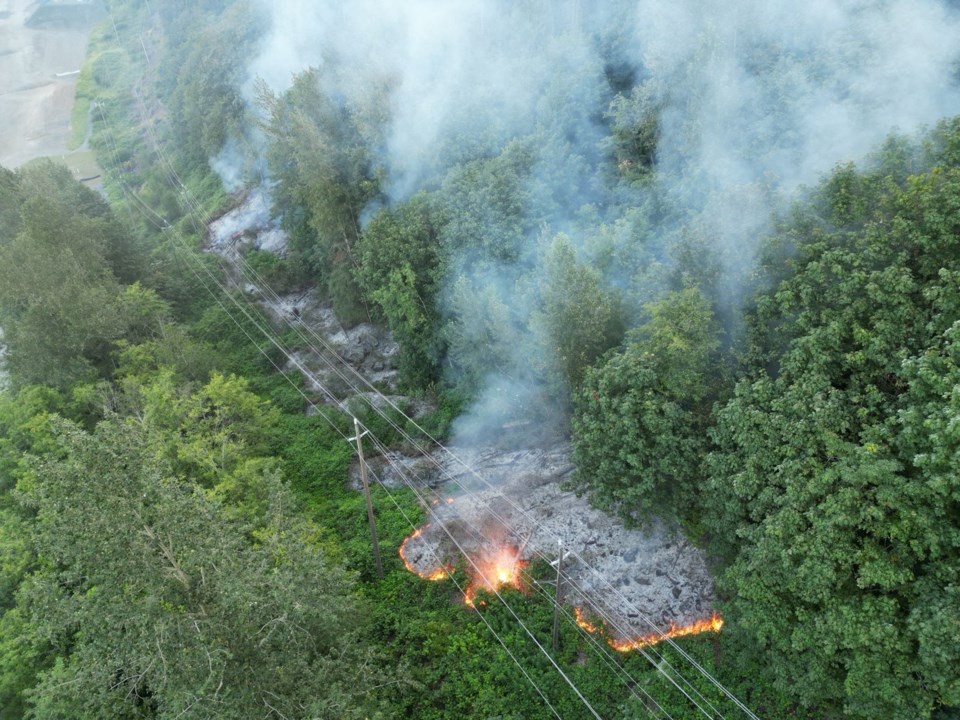The mayor of a British Columbia Interior community says the area's long-term care residents have been moved out as a fast-moving wildfire looms nearby.
Barbara Roden, mayor of Ashcroft, sa���ʴ�ý, located about 360 kilometres northeast of Vancouver, said Saturday that community remains under an alert to be ready to evacuate on short notice.
Roden said the anxiety among residents is "settling down a little bit" as the nearby Shetland Creek wildfire appeared to push northward Saturday.
"In the early stages of a fire, there is of course a lot of stress, a lot of fear, a lot of nervousness," she said. "(But) we've seen that the fire has largely stayed in a northerly course, not veering off to the east towards Ashcroft or Cache Creek, the more populated areas in this region."
Roden said crews have also helped the community's psyche by keeping nearby Highway 1 open despite the Shetland Creek blaze growing to about 150 square kilometres in size.
"The highway has remained open throughout, which is … I think, a big stress relief for people," she said. "Not just because it's an evacuation route possibly, but just because having a highway open, it's almost a feeling of normalcy with traffic still moving up and down the highway."
Nevertheless, Roden said Interior Health has decided to relocate 21 long-term care residents and five in assisted-living facilities from Ashcroft in case the fire changes direction.
"I think right now, we're in a stage where it's wait-and-see what the fire is going to do," she said.
Roden's comments came as the Thompson-Nicola Regional District confirmed Venables Valley — just a few kilometres southwest of Ashcroft — has seen a number of structures destroyed by the Shetland Creek fire as of Saturday.
The regional district's emergency centre said officials have not been able to access the area to assess specific numbers, but preliminary estimates put the number of structures destroyed at less than 10.
Meanwhile, the number of wildfires in British Columbia has flared up to more than 300, with more than half of those classified as out of control and about 70 started in the last 24 hours.
The BC Wildfire Service said one of the primary drivers in the latest spike has been lightning; officials estimate there have been close to 1,300 strikes in the province since Wednesday and 94 new ignitions.
Firefighters in the province's northwest said that region received "significant lightning" on Friday resulting in 13 new fires, although three have been extinguished.
The wildfire service said the situation has been exacerbated by dryness, as recent heat waves across the province have created conditions conducive to higher fire activity.
"The prolonged hot and dry conditions being experienced across the Southeast Fire Centre, paired with passing storm systems, means that residents can expect to continue to see increased overall wildfire activity across the region," the BC Wildfire Service said in its Saturday update on social media.
"With no rainfall in the southern regions the fire danger is high to extreme in most areas," the service said in a separate update Saturday.
In addition to Ashcroft, the Shetland Creek fire has so far triggered evacuation orders and alerts in Cache Creek, Spences Bridge, the Ashcroft First Nation and several Cook's Ferry Indian Band reserves.
Further east, another two fires ignited by lightning in the Kootenay region have prompted evacuation orders for 107 properties south of Silverton, sa���ʴ�ý
The Regional District of Central Kootenay said the Aylwin Creek and Komonko Creek blazes near the shores of Slocan Lake have reached a combined 6.5 square kilometres in size.
The regional district has also issued an alert for Silverton itself, with residents told to be ready to evacuate on short notice and Highway 6 in the area closing due to the adjacent blazes.
In northwestern sa���ʴ�ý, the Regional District of Bulkley-Nechako has issued an evacuation order for the Laidman and Williamson lakes areas about 110 kilometres southwest of Vanderhoof.
The wildfire service said skimmers and helicopters will be using local water sources in many places such as the Arrow and Kootenay lakes area as well as in the Columbia fire zone, and boaters are asked to stay away from aircraft involved in the firefighting effort.
People are also being asked to stay away from firefighters' work sites for similar safety reasons.
"People using other watercraft in the intended flight path present a serious safety risk for aircrews and anyone else in the area," the BC Wildfire Service statement says. "This behaviour is extremely dangerous and interferes with our ability to fight wildfires."
Heat warnings continue to cover a large section of south and eastern sa���ʴ�ý, with Environment sa���ʴ�ý reporting the Kelowna, Cranbrook, Vernon and Nakusp areas all broke high-temperature records on Friday. Highs in Kelowna reached 38.6 degrees.
The federal weather agency warned the above-average temperatures will likely last into early next week.
Along with the high temperatures and nearby wildfires, forecasters said smoke conditions are also expected to increase, while fires burning in Alberta are expected to bring smoke into the northeastern corner of sa���ʴ�ý
Environment sa���ʴ�ý has issued special statements about the wildfire smoke affecting air quality in places such as the Slocan Lake, Peace River, East Kootenay, Fort Nelson and South Thompson areas, asking residents to limit outdoor activities.
BC Wildfire Service said there are almost 1,000 provincial firefighters on the ground along with resources from Nova Scotia and Ontario as well as Australia and New Zealand.
This report by The Canadian Press was first published July 20, 2024.
Chuck Chiang, The Canadian Press



